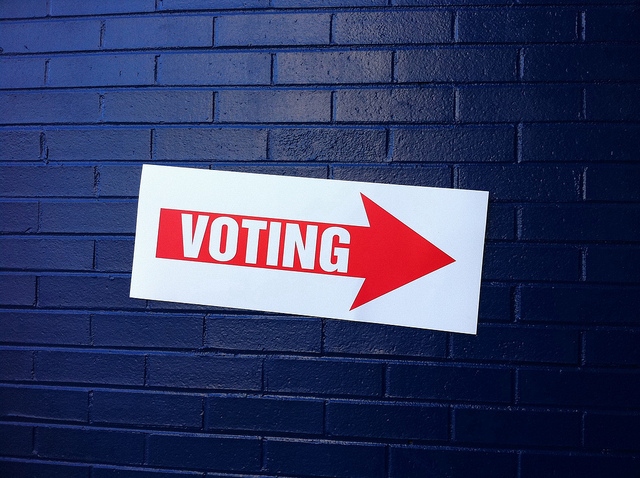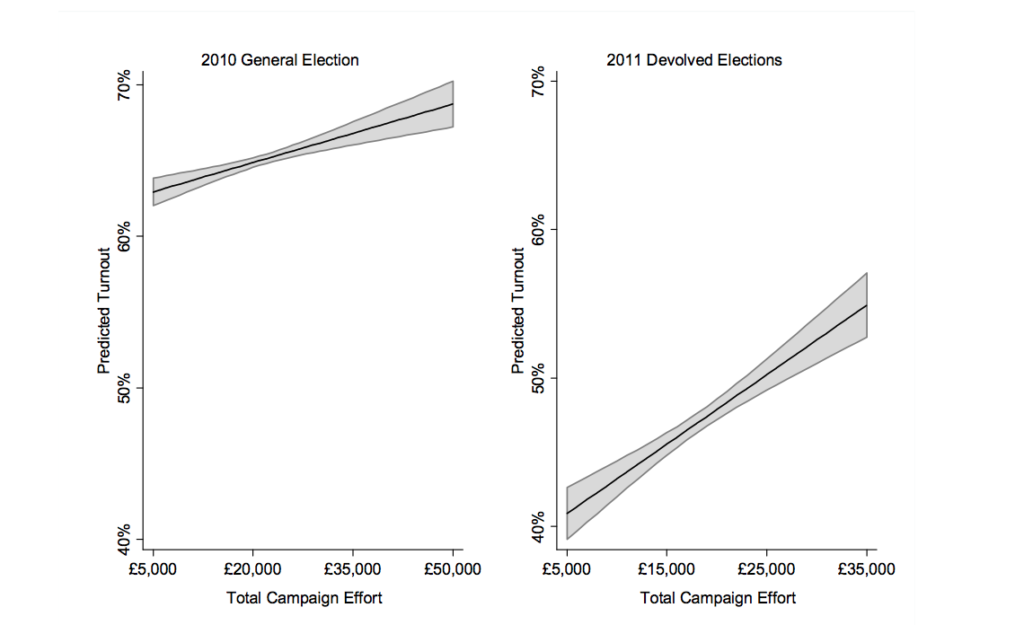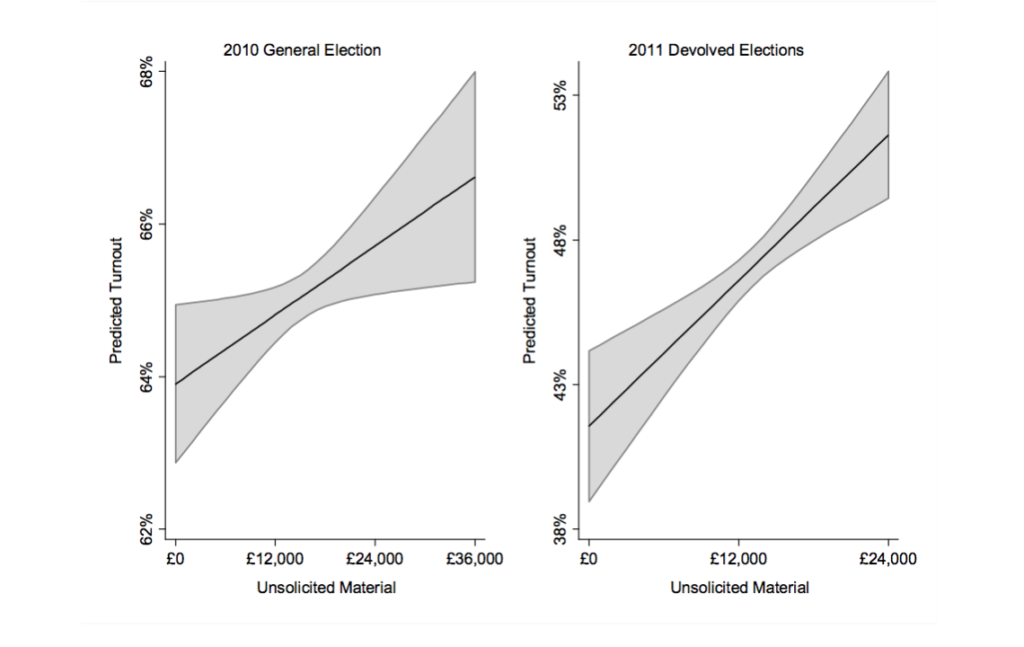When parties engage voters on the ground, they intensify public interest in elections and improve turnout
Local campaigns play a key role in Britain in mobilising the electorate. Here, Siim Trumm and Laura Sudulich compare the effects of different campaign activities on voter turnout at general and devolved elections. They find positive mobilisation effects for money spent on the distribution of unsolicited material and paid staffers.

Credit: justgrimes, CC BY SA 2.0
Levels of electoral participation function as thermometers of how healthy a democracy is. When large numbers of citizens fail to turn out to vote, not only do they abstain from making a political choice, but they also signal a wider detachment from the conventional democratic process. Turnout has been declining across Europe in recent years. Even countries with a tradition of strong electoral participation like Italy, the Netherlands, and France have been experiencing falling turnout figures. In recent decades, there has also been a notable decline in party membership, ideological attachment and ‘brand’ loyalty, leaving parties without a strong core of supporters and in need to make extra efforts to bring voters to the polling station. The mobilising efforts, engineered by parties and their candidates, are therefore particularly significant at this time.
Yet, are mobilisation efforts effective? Are all types of campaign activities equally useful at getting out the vote? We recently investigated the efficacy of campaign efforts in a study of the 2010 general election in Britain and the 2011 devolved elections in Scotland and Wales.
Local campaign efforts matter in general and devolved elections
We know that turnout varies considerably across different constituencies. For example, in general elections turnout is consistently over 70% in places like East Dunbartonshire and Twickenham, whilst remaining at around 50% in constituencies like Stoke-on-Trent Central and Manchester Central. In searching for an explanation of what determines such differences, we assess the role of local campaign mobilisation. If local campaigns are effective at getting out the vote, turnout should be higher in constituencies where campaigns are more intense. Where candidates spend more money on electioneering activities voters bare lower cost in acquiring electorally relevant information, leading to higher likelihood of participating.
Figure 1 shows the effect of the total campaign effort put in place by all local candidates on voter turnout in the 2010 general election and the 2011 devolved elections. The story that unfolds is consistent across both contexts: turnout is greater in constituencies where local candidates carry out more intense campaigns. Nuance is offered here by the comparison of the two effects. Whilst an extra £1,000 spent in a Westminster constituency corresponds to an average rise of 0.1% in turnout, a similar £1,000 increase in the context of the 2011 devolved elections is associated with 0.5% higher turnout. Local campaigns seem to be more effective in getting out the vote in the context of the devolved elections.
Figure 1: Effect of constituency-level campaign effort on turnout

We dig deeper into the effectiveness of local campaigns at getting out the vote by comparing the effects of different forms of electioneering on turnout.
Electoral spending of candidates in Britain is regulated by the Representation of the People Act 1983 and the Political Parties and Elections Act 2009, with campaign expenses divided into (1) advertising, (2) unsolicited material, (3) transport, (4) public meetings, (5) staff, and (6) accommodation and administration. Using the same distinction, we estimate how different campaign activities mobilise voters. Is advertising more effective in stimulating turnout than the distribution of unsolicited material? Can public meetings bring new voters to the polls or are they simply talking to those already politically engaged?
Our findings show that campaign activities differ in their ability to mobilise voters in the run up to both the general and devolved elections. In particular, distributing unsolicited material stands out as being influential in every electoral context. Campaign material that reaches voters at home does have the capacity to stimulate electoral participation. In addition, we find that Westminster constituencies where candidates spend more money on paid staffers – indicating greater level of campaign professionalisation – are experiencing higher turnout levels. Spending on the four other categories, however, does not seem to systematically influence turnout in either electoral context.
Figure 2: Effects of different campaign activities on constituency-level turnout

Figure 2 gives a sense of how different forms of electioneering influence turnout. In case of the 2010 general election, extra £1,000 spent in a constituency on unsolicited material brings about an increase of 0.1% in turnout, while a similar rise in the lead up to the 2011 devolved elections corresponds to 0.4% higher turnout. In addition, we found that an extra £1,000 spent in a Westminster constituency on paid staffers leads to a 1% average increase in turnout. Not every type of campaign activity has a discernible impact on voter turnout, but some certainly do, and their contribution to electoral mobilisation is rather significant.
Our findings highlight two key elements. First, while we often think of devolved elections as something rather different from general elections – they use different electoral systems, are characterised by lower levels of public interest and weaker turnout, there are also important similarities between the two. Local campaigns influence how many people turn out to vote in both types of elections; they do so in marginal constituencies as well as the safe ones, and show relatively homogenous trends when comparing electoral mobilisation effects associated with different campaign activities. Whilst general and devolved elections are still different in many respects, they do not appear substantially dissimilar when it comes to the effects of local campaign efforts. When parties and candidates actively engage on the ground by increasing their efforts to win votes, they simultaneously intensify the broader public debate surrounding the election and incentivise turnout by (re)engaging the public.
—
Note: This article gives the views of the author, and not the position of Democratic Audit UK, nor of the London School of Economics. Please read our comments policy before posting.
—
Siim Trumm is Senior Lecturer in Politics at Swansea University.
Laura Sudulich is Senior Lecturer in Politics at the University of Kent.





 Democratic Audit's core funding is provided by the Joseph Rowntree Charitable Trust. Additional funding is provided by the London School of Economics.
Democratic Audit's core funding is provided by the Joseph Rowntree Charitable Trust. Additional funding is provided by the London School of Economics.
When parties engage voters on the ground, they intensify public interest in elections and improve turnout https://t.co/3Kid2hFPDF
When parties engage voters on the ground, they intensify public interest in elections and improve turnout https://t.co/5rePbbci4Z
When parties engage voters on the ground, they intensify public interest in elections and… https://t.co/xGZvaekbto https://t.co/Cx2Cr2M1kD